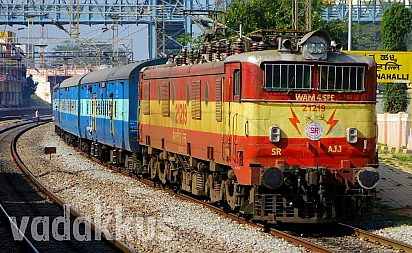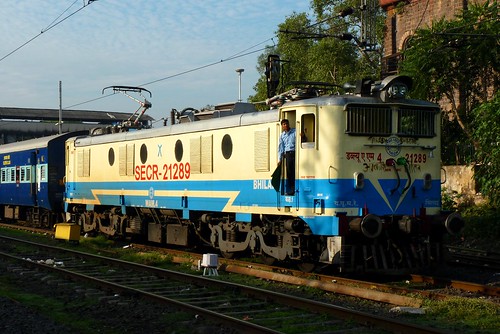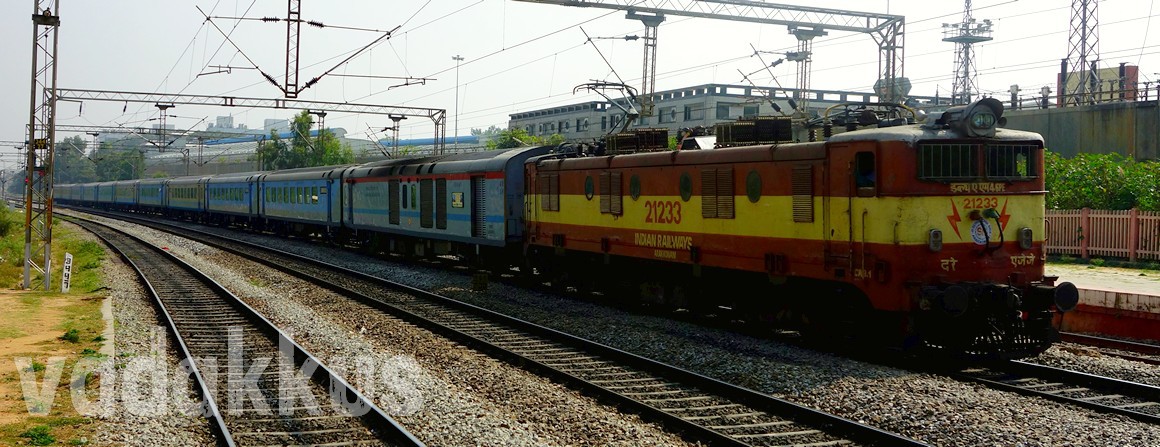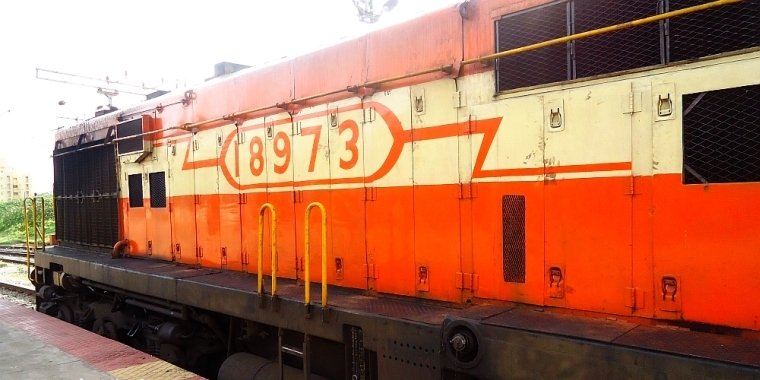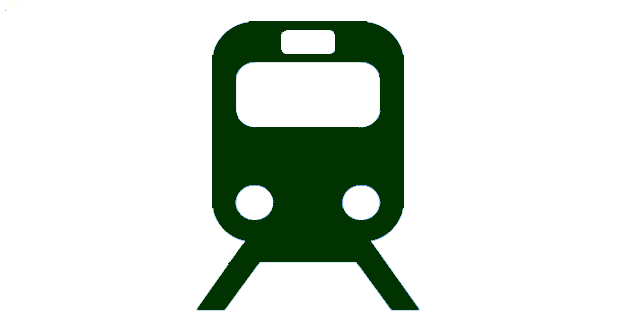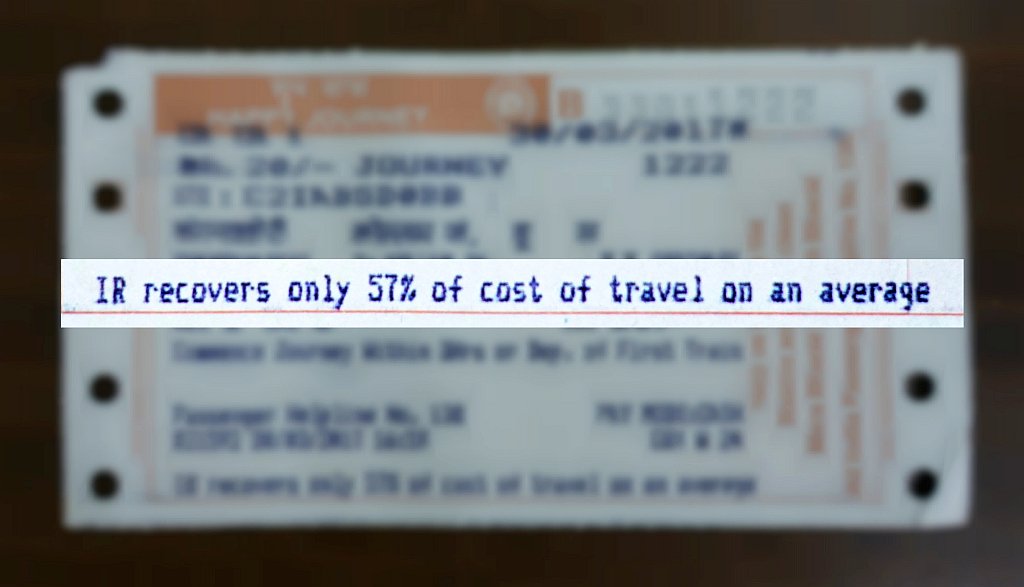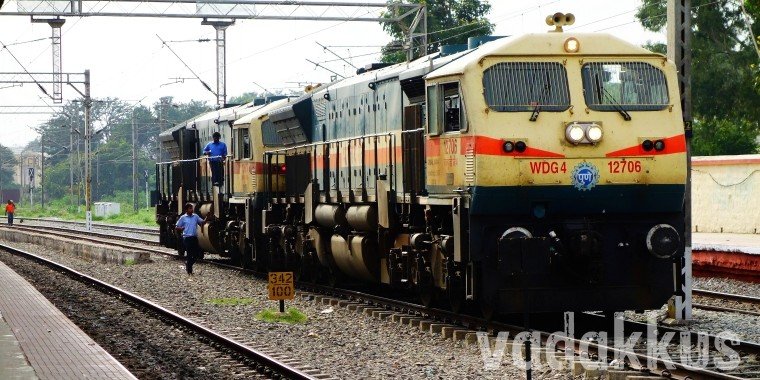AC Electric Locomotives Roster: The WAM Series!
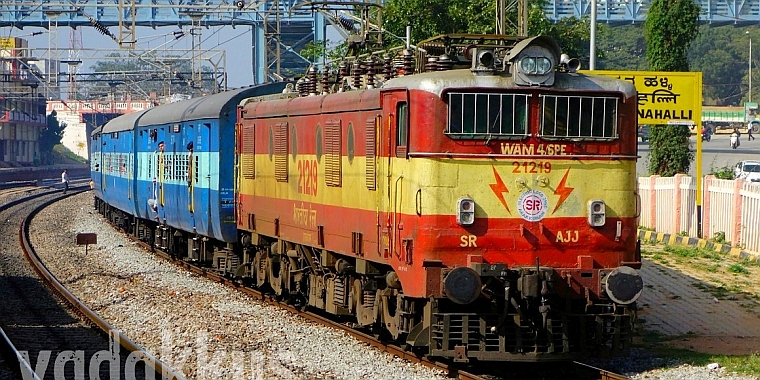
After Indian Railways switched over to 25kV alternating current traction all over its network rendering DC traction and DC (and AC/DC) locomotives obsolete, AC electric locomotives are currently the reigning superstars of Indian Railways. They are the fastest and most powerful among all locomotives in India, hauling most of IR’s crack and premier trains. Like all other traction types, AC locomotives are of three types: The WAM (Freight and Passenger service), WAG (Freight) and WAP (Passenger), the ‘A’ denoting AC traction as per Indian Railways’ locomotive classification system. There were 4 series of WAM class locos produced, with only the WAM4 still in service today and none in production. In this section we will take a long, hard look at these beasts.
Brief History of AC Railway Electrification in India: At independence India had 388 km of electrified railway track, all running 1500V DC installed by the British in the 1920s. The Howrah – Burddhaman section was electrified using 3000 V DC in 1957. But by the 1950s, European countries were running their trains using 25000V 50Hz Alternating Current (AC) and single phase locos with great deal of economic success. The French railway company SNCF was the pioneer and leader in pushing AC current to be made the the de-facto technology for railway electrification the world over. IR appointed SNCF as a consultant on their recommendation decided to adopt 25kV 50Hz AC traction for mass-electrification of India’s railway lines in 1957 with work on it starting that very year. Today 48% of Indian Railway lines is electrified using 25kV AC and more is under process.
WAM 1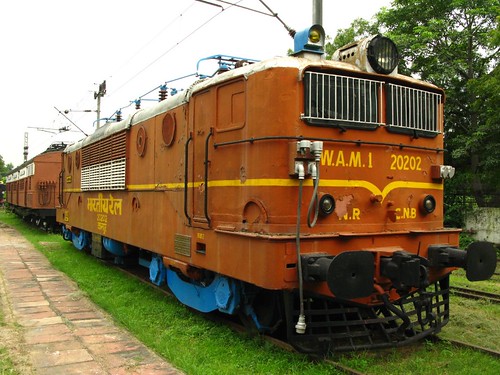
- Very first AC electric locomotives in India
- All imported from a European consortium
- Production Period: 1959-1961
- Numbers Produced: 100
- Max Power: 3010 hp
- Top Speed: 100 kph
- Wheel Arrangement: Bo-Bo
- Weight: 74t TE: 25t AL: 18.64t
The WAM1 was not only India’s very first AC electric locomotive but also the great granddaddy of all Indian AC electric locomotives (except the three-phase WAP5/7 and WAG9). The real challenge for AC electric railway traction technology to work in India was building locomotives for it as there never was any 25kV 50Hz Single Phase AC traction 1676 mm gauge locomotive in the world. The French gave a helping hand here too. In 1957 the Groupement 50Hz (50Hz/50 Cycles Group), a consortium of European locomotive manufacturers were entrusted with the task and two years later in 1959 they delivered India’s first AC electric locomotive the WAM1 (initially classified BBM1), with the first WAM1 #20202 “Jagjivan Ram” (preserved at the NRM, New Delhi) entering service the same year (#20200 and #20201 were probably only prototypes or testing locos). The initial WAM1s were not great successes as some of their features were just too advanced for Indian conditions, though they were terrific performers in Europe. It had only 4 axles, 2 each on its two bogies, driven by four DC traction motors (Bo-Bo) through a “Jacqemin drive” or through a set of gears. (The WAG1 which was produced along with this had only two traction motors on Monomotor B-B bogies!) They came with Ignitron (water-cooled Mercury-ignited) rectifiers for AC-DC conversion but were later retrofitted with Excitron (externally ignited) rectifiers which were more suitable for Indian use. The WAM1 “evolved” down the line into various variants and classes, making all of India’s single-phase electric locomotives until the WAP4 and WAG7 either direct descendants of the WAM1 or inspirations. The WAM1 (and WAG1) was designed according the SNCF locomotive design philosophy of the 1950s and 1960s to look like a CC 7100 or BB 16000, and since we never bothered to change our designs, all WAM and WAG series locomotives (except some WAG7s and the WAG9) look like a 1950s French locomotive. All WAM1s are out of service today.
WAM 2
- Similar in specs to the WAM1
- All imported from Japan
- Production Period: 1959-1961
- Numbers Produced: 36
- Max Power: 2910 hp
- Top Speed: 112 kph
- Wheel Arrangement: Bo-Bo
- Weight: 76t TE: 25.24t AL: 19t
While the WAM1 was European, the WAM2 was Japanese. It was built by a consortium of Mitsubishi, Hitachi and Toshiba (The Japanese Group, as attested by a plaque fixed on their sides) as IR probably wanted a second opinion to the Europeans. They were delivered in 1960 and were a bit lower powered than the WAM1 but had similar Bo-Bo wheel arrangement (4 wheels per bogie) with four Mitsubishi DC traction motors connected to the wheels permanently in parallel through a WN geared drive. The WAM2 had Ignitron rectifiers just like the WAM1 but some were later were refitted with Excitron rectifiers. 38 were produced in two batches with the second batch having only vacuum brakes. Some even had the Mitsubishi logo painted on their sides! Like the WAM1 they were also used around the ER-SER-NER-NR circuit as it was the first AC electrified area and hauled ordinary passenger trains and freights only.
WAM 3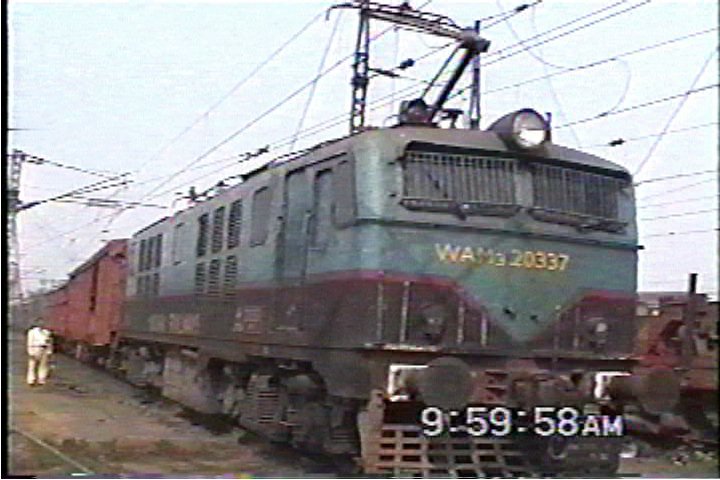
- Rebuilt and improved WAM2
- Rebuilding done by CLW
- Production Period: 1961
- Numbers Produced: 2
- Max Power: 2910 hp
- Top Speed: 112 kph
- Wheel Arrangement: Bo-Bo
- Weight: 76t TE: 25.24t AL: 19t
The WAM3 class consisted of two modified WAM2 locomotives, #20333 and #20337 of the Asansol ASN shed of Eastern Railway. They were rebuilt with their Pantographs aligned the other way around (pointing outwards) for some reason and fitted with silicon diode rectifiers as permanent feature thereby increasing their performance and durability, but were identical to the WAM2 in every other respect. These two were used to haul (then) prestigious trains like the Kalka Mail and Toofan Express to Delhi, but were later relegated to passenger duties and shunting as WAM4s became common. Both are scrapped now. See a rare video of them in action here.
WAM 4 “Old Monk”
- First locomotive completely designed and developed in India by Indians
- Designed by RDSO, built by CLW
- Production Period: 1970-1983
- Numbers Produced: 500
- Max Power: 3850 hp
- Top Speed: 120 kph
- Wheel Arrangement: Co-Co
- Weight: 112.8t TE: 33.8t AL: 18.8t
The WAM4 is a legend. Known fondly as “the Old Monk” among railfans, it was the WDM3D of Indian Railways’ AC electric locomotives, the result of what Indian Railway engineers do best: adapting best features of foreign locomotives to create optimal locomotives for India. It took the RDSO and CLW only 10 years after the first WAM1 rolled out to come out with the completely “made in India” WAM4. Though indigenous, they were ‘inspired’ by the WAM1 and WAG1 with added Silicon Diode rectifiers and rheostatic braking. However, the masterstroke was adapting those ultra-successful ALCO Trimount bogies of the WDM2 for the WAM4. With the huge success of the ALCO, IR had finally figured out that Co-Co (two bogies with three axles each, all axles powered by individual traction motors) was the most favorable wheel arrangement configuration for India as it provided more stability and pulling power for typical heavy loaded Indian trains at the cost of some speed. All these factors culminated in the WAM4s celebrated versatility, easy maintenance and ruggedness leading to the huge success of the class. Sheds and workshops across the country created their own modifications to the WAM4 resulting in a huge number of variants and subtypes. Unlike the diesels, subtype notations here do not mean power but modifications on the locomotive. Some of those are:
- WAM4B or G: Freight only (regeared version)
- WAM4D or DB: Dual Braked (Air and Vacuum)
- WAM4E: Air Brake only (for both loco and train)
- WAM4H: Hitachi Traction Motors instead of Alstom
- WAM4P: Passenger only (regeared version)
- WAM4/2S3P: 2 TMs in Series, 3 in Parallel
- WAM4/6P: 6 traction motors permanently in parallel
- WAM4/6PE: Air braked, 6 TMs perm. in parallel
- WAM4/6PDBHS: 6 Traction Motors permanently in parallel, Dual Brakes, High Speed
And so on. Initially all WAM4s were vacuum braked but many were later converted to air or dual braked which enables them to be in operation even today. They were the first to feature the popular Alstom TAO-659 traction motors (TMs) which is also used in WAG5s, WCAM1s and even WAG7s after much technical redesigning. These TMs could be configured to be connected in various series/parallel configurations for efficient hauling as per load type controlled by varying amounts of power (all series on start, 2S/3P or 3P/2S as per load later and all in P at speed). With the WAG class getting more and more numbers, WAM4s were almost completely dedicated for passenger duties with permanently Parallel connected TMs. The first WAM4 built was #20400 and the last one was #21399 “Anant” which rolled out of CLW on August 3, 1983. Exactly 500 WAM4s were built in 13 years, all by CLW, and as on December 31 2014, 216 out of them were still in service.
The WAM4 “electrified” India like none before. With their sheer numbers, they created a pan-India impact the WAM1, 2 and 3 mostly confined to the Eastern parts of the country could not. By the time of the WAM4, electrification had spread throughout India and they could easily be maintained and serviced anywhere, so it found homes at many more sheds including Arakkonam (Chennai), Vizag, Baroda, Bhusaval, Itarsi, Tata, Bhilai, Delhi and so on. WAM4s hauled almost all prestigious trains on electric traction India until the mid-1980s. Here is one with the GT in 1986. WAM4s and WAG5s with their long, boxy shape and trademark circular windows and “flush” to the train stance became the trademark for electric traction in India. The impact the WAM4 has had on Indian Railways can be ascertained by the fact that the WCAM1, the WAG5 and the WAP1 and WAP4 are all directly based on it! At around 30 years of age now, most of them still have the spunk and power in them, hauling even Premier Express trains like the Shatabdis and Premium trains at high speeds. But sadly more and more of them are being scrapped.
The End of the WAM Era and the Rise of the WAP Classes
The WAM4 also created an interesting conundrum in the Indian Railways. As the WAG class became the de-facto freight-carrying locos on electrified sections, and the bulk of freight was being moved by diesel anyway, a large number of WAM4 locomotives were retrofitted to become dedicated passenger locos. By the later 1970s with the WAG class being expanded to exclusively meet freight carrying needs and electrification planned for almost all of IR’s important lines, Indian Railways realized that it is imperative they develop high-speed locomotives dedicated for passenger operations. Hence, the WAM4 became the last “mixed” service AC electric locomotive as there wouldn’t be a need for a “mixed” class locomotive anymore. In 1980, the WAP1 was born (out of the WAM4 anyway), heralding another era of modernization in the Indian Railways. But before that were the WAGs.
About Groupement 50hz: Also known as the 50 cycles group, 50 Hertz group or the European Group, this was a consortium of many European locomotive/component manufacturers formed to pioneer and promote adaptation of 50Hz Alternating Current (AC) technology as traction power among railways throughout the world. The consortium was headed by Alstom and included Schneider-Westinghouse, Siemens, Brown-Boveri & Cie, Kraus-Maffei, (Thyssen) Krupp, AEG, SFAC, ACEC, La Brugeoise et Nivelle, MF Oerlikon, Henschel, Sonefarm, SNCF and some others. The Group under the auspices of SNCF recommended 25,000V 50Hz AC traction for India as it was more efficient, did not require high maintenance and was easy to build and operate as opposed to the 1500/3000V DC traction technology India was using. The Group also built and supplied both of Indian Railways’ first AC electric locomotives, the WAM1 and WAG1.
Photo Credits: WAM1: Jimmy Jose, WAM2: Harsha Vardhan (IRFCA), WAM3: Vijay Balasubramanian (IRFCA), WAM4 (21289): Ujjawal.
More Chapters on Indian Locomotives
Locomotives of the Indian Railways | Locomotives Terminologies and Design
How Locomotives are Classified | How Electric and Diesel Locomotives Work
DIESELS: The WDM Series (ALCOs) | The WDP and WDG Series (ALCOs and EMDs)
ELECTRICS: DC and AC/DC Locos | The WAM Series (AC mixed) | The WAG Series (AC Freight)

